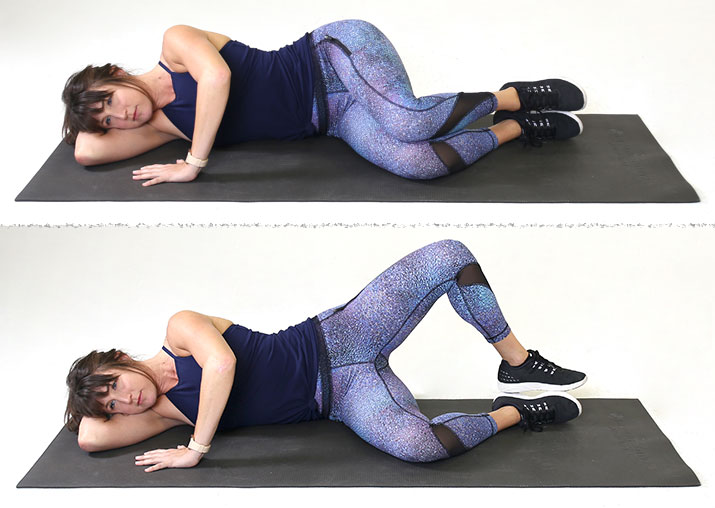Clamshell exercise
Squat, lunge, leg press…clamshell?
Perhaps you’ve never heard about the specific leg and hip strengthening exercise, but it is one that you need to think about adding to your workout plan. Named for the way that your legs and buttocks resemble a clamshell when performing the movement, this exercise will strengthen your hips and thighs while also stabilizing your muscles and toning your glutes.
You are able to do the clamshell exercise nearly everywhere, with minimal space and little to no equipment needed for a successful lower body work out.
Why should you attempt it?
Not only can it be amazing for strengthening the hips, glutes, and pelvis, but also the clamshell may also help to prevent injury and ease lower back tension.
A study published in the Journal of Orthopaedic and Sports Physical Therapy discovered that the clamshell practice is among the most appropriate for hip strengthening and assisting with injury prevention and treatment. The clamshell exercise is often utilized in physical therapy to help with back pain and sciatica. It is helpful to reduce pain by strengthening the heart and lower back muscles.
Through the years, there have been many different workouts targeting the glutes, with the goal of lifting, lifting, and toning your lower half. What most individuals don’t see is that there are numerous muscles that make up your cervical, and all of them need to be worked to be able to build tone and strength.
The 3 key muscles of the buttocks are the gluteus maximus, gluteus medius, and gluteus minimus. While the gluteus maximus usually gets all of the glory because it’s the biggest of the buttock muscles and impressively the biggest muscle in your whole body, the other gluteus muscles are equally as important. If they are weak, then additional muscles will eventually have to overcompensate, which can lead to pain and injury.
The clamshell exercise may specifically help strengthen the gluteus medius, which lies on the outer border of their buttocks and can be responsible for strengthening your pelvis. Clamshell exercises can help to balance the muscle effort between your inner and outer thighs as well as your pelvic floor. Creating balance in the leg and hip muscles help prevent overuse and trauma.
Who should take action?
Hip strengthening exercises are particularly critical for runners or anyone who plays sports where running is involved, such as soccer or tennis.
Runners may gain from this hip-strengthening exercise since they’re more likely to be more prone to injuries coming from feeble shoulders. Most runners don’t realize that the cause of the majority of foot, ankle, and knee pain originates from the hips!
In fact, inadequate hip stabilization can be the underlying reason for many accidents. To avoid such injuries, exercises like the clamshell can create equilibrium between the thighs, glutes, and pelvic floor. And of course, this workout feels fantastic on tight buttocks.
How to perform a basic clamshell exercise with Appropriate form
- Lie on your side, with thighs piled and knees bent in a 45-degree angle.
- Rest your head on your lower arm, and make use of your upper arm to steady your frame. Make certain that your hipbones are piled together with one another, as there’s a trend for the very best hip to rock backward.
- Engage your abdominals by pulling your belly button as this will help to stabilize your spine and pelvis.
- Maintaining your feet touching, raise your upper knee as high as possible without altering your hips or pelvis. Don’t move your leg off the floor.
- Pause, then return your leg to the starting place on the ground. Do 20 reps on each side.
There are lots of variations of the clamshell exercise. Here is a couple to get you started.
Clamshell Exercise using a resistance band
To up the ante of a regular clamshell rotation, try including a resistance band. This can help to work the glutes and hamstrings much more, for a strong core and spine.
- Set the band around both legs, just above the knees.
- Lie on one side with knees in a 45-degree angle, legs and hips stacked.
- Contract your abdominal muscles to stabilize your core.
- Keep your toes in contact with one another because you raise your knee as high as you can, without moving the hips or pelvis. Don’t let your lower leg to move off of the ground.
- Pause at the top for a couple of seconds before returning the top knee to the beginning position. Do 20 repetitions on each side.
Clamshell with Dumbbell spinning
To do double duty and work both upper and lower body at exactly the exact same time, try adding dumbbells. This will raise the burn into your glutes, in addition, to help tone the obliques and shoulders. Talk about a full-body workout!
- Lie on your side at the conventional clamshell position, with elbows bent at a 45-degree angle. Hold a 3-, 5-, or 8-pound dumbbell in your upper hand, keeping your elbow in at your side.
- Lift both your upper arm and upper leg to the ceiling at approximately 90 degrees, keeping hips stacked and center participated. This is a twist on the normal clamshell, where you lift your complete top leg, as opposed to just your knee.
- Keep your elbow bent into your side and your leg on the ground.
- Hold at the top for a couple of seconds before returning to the beginning position. Repeat 10 times, then switch sides.
Clamshell with stability ball crunch
This really is a different variation on the clamshell, but it is going to work your abs and fire up the center.
- Lie on your back, with a stability ball placed between your lower legs.
- Together with your palms placed behind your head, simultaneously lift your legs off the floor while also lifting your shoulders off the ground. This may work your abs, hip flexors, and rectal muscles.
- Hold for a couple of seconds before returning to the start position. Repeat 10 times.
Clamshell Exercise Tips
- Maintain your heart participated! This will trigger your stomach muscles and protect your spine.
- Try to isolate the glutes. You should only be rotating out of the hips, not the lower back.
- Be sure that your neck is in a neutral position so that you don’t strain it.



